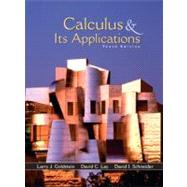
| Preface | |
| Introduction | |
| Functions | |
| Functions and Their Graphs | |
| Some Important Functions | |
| The Algebra of Functions | |
| Zeros of Functions-The Quadratic Formula and Factoring | |
| Exponents and Power Functions | |
| Functions and Graphs in Applications | |
| The Derivative | |
| The Slope of a Straight Line | |
| The Slope of a Curve at a Point | |
| The Derivative | |
| Limits and the Derivative | |
| Differentiability and Continuity | |
| Some Rules for Differentiation | |
| More About Derivatives | |
| The Derivative as a Rate of Change | |
| Applications of the Derivative | |
| Describing Graphs of Functions | |
| The First and Second Derivative Rules | |
| The First and Second Derivative Tests and Curve Sketching | |
| Curve Sketching (Conclusion) | |
| Optimization Problems | |
| Further Optimization Problems | |
| Applications of Derivatives to Business and Economics | |
| Techniques of Differentiation | |
| The Product and Quotient Rules | |
| The Chain Rule and the General Power Rule | |
| Implicit Differentiation and Related Rates | |
| Logarithm Functions | |
| Exponential Functions | |
| The Exponential Function ex | |
| Differentiation of Exponential Functions | |
| The Natural Logarithm Function | |
| The Derivative of ln x | |
| Properties of the Natural Logarithm Function | |
| Applications of the Exponential and Natural Logarithm Functions | |
| Exponential Growth and Decay | |
| Compound Interest | |
| Applications of the Natural Logarithm Function to Economics | |
| Further Exponential Models | |
| The Definite Integral | |
| Antidifferentiation | |
| Areas and Riemann Sums | |
| Definite Integrals and the Fundamental Theorem | |
| Areas in the xy-Plane | |
| Applications of the Definite Integral | |
| Functions of Several Variables | |
| Examples of Functions of Several Variables | |
| Partial Derivatives | |
| Maxima and Minima of Functions of Several Variables | |
| Lagrange Multipliers and Constrained Optimization | |
| The Method of Least Squares | |
| Double Integrals | |
| The Trigonometric Functions | |
| Radian Measure of Angles | |
| The Sine and the Cosine | |
| Differentiation and Integration of sin t and cos t | |
| The Tangent and Other Trigonometric Functions | |
| Techniques of Integration | |
| Integration by Substitution | |
| Table of Contents provided by Publisher. All Rights Reserved. |
The New copy of this book will include any supplemental materials advertised. Please check the title of the book to determine if it should include any access cards, study guides, lab manuals, CDs, etc.
The Used, Rental and eBook copies of this book are not guaranteed to include any supplemental materials. Typically, only the book itself is included. This is true even if the title states it includes any access cards, study guides, lab manuals, CDs, etc.